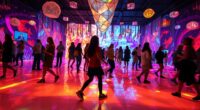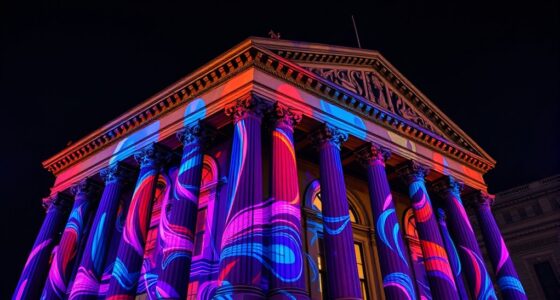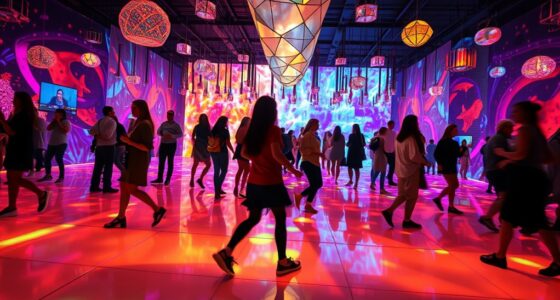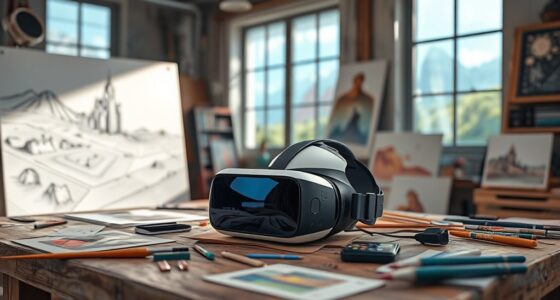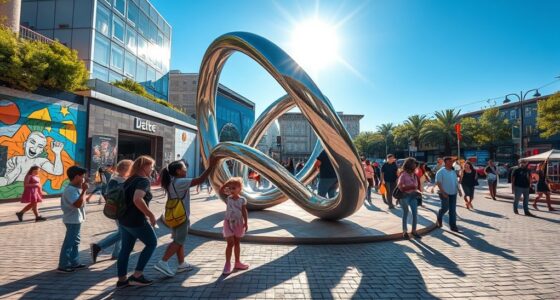Light projections transform art by creating immersive, dynamic experiences that engage your senses beyond traditional visual forms. Techniques like projection mapping and LED displays turn surfaces and spaces into lively canvases, while interactivity allows you to influence and participate in the artwork. Iconic landmarks and public spaces are reborn through these innovative visuals, pushing artistic boundaries. To discover how technology continues to shape these mesmerizing environments, explore further.
Key Takeaways
- Light projections convert architectural surfaces and landscapes into dynamic visual canvases, creating immersive environments.
- Projection mapping aligns images precisely on irregular surfaces, transforming landmarks into storytelling artworks.
- Advanced LED and projection technologies enable vibrant, large-scale displays that captivate and engage viewers.
- Interactive elements like AR and participatory sculptures foster active audience involvement in light-based art.
- These techniques evolve traditional art forms, offering innovative, multisensory experiences that redefine public and gallery spaces.
The Evolution of Light Projections in Art
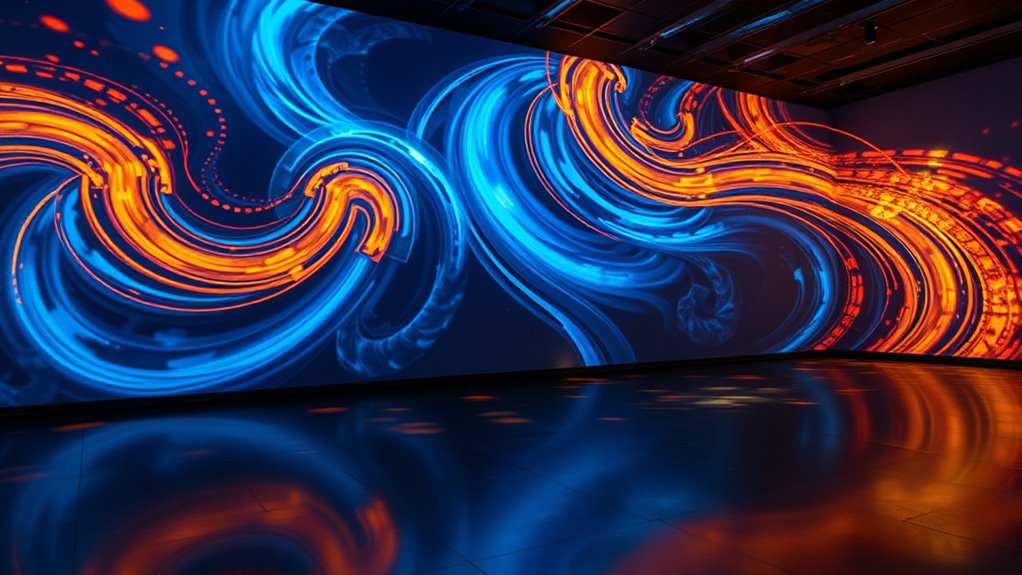
Have you ever wondered how light projections transformed from simple displays into immersive art forms? The journey begins with key historical milestones, like the early use of slide projections and lantern shows in the 19th century. These innovations inspired artists to explore new visual boundaries, influenced by movements such as Impressionism and Futurism, which emphasized light and motion. As technology advanced, projectors became more sophisticated, allowing for larger, more complex displays. Artistic influences from theater and cinema also played a role, pushing light projections from static images to dynamic narratives. Over time, these milestones laid the foundation for the immersive light experiences we see today, blending technology and creativity to redefine how we interact with art. Additionally, the evolution of light projection technology has enabled artists to create more interactive and engaging installations.
Techniques Behind Immersive Light Displays
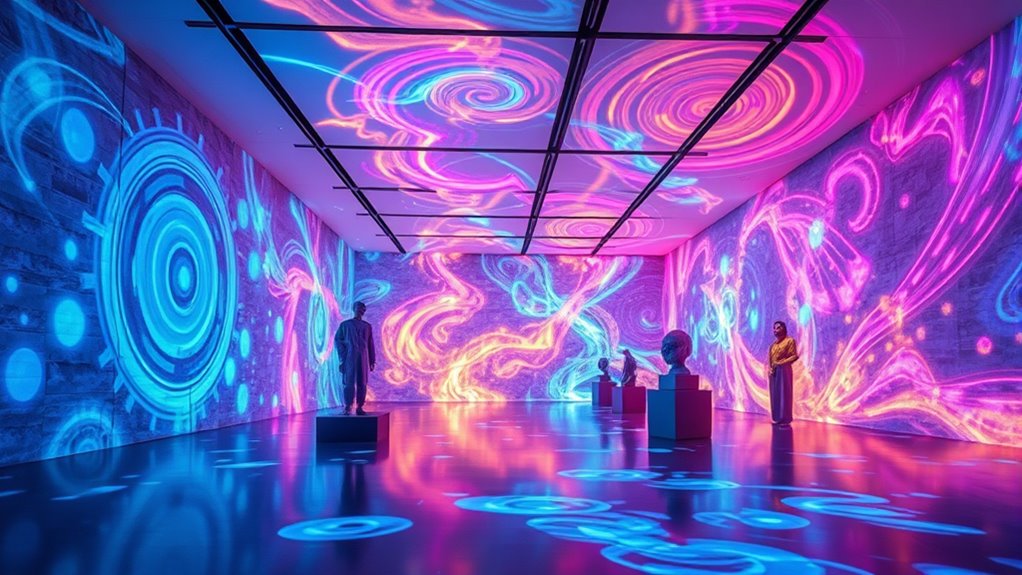
What makes immersive light displays so enchanting is the variety of techniques artists and technologists employ to create these mesmerizing environments. LED techniques play a vital role, allowing creators to produce vibrant, dynamic lighting that can change colors and patterns seamlessly. These LEDs are flexible and energy-efficient, making them ideal for large-scale installations. Projection mapping technology is another powerful tool, enabling you to transform irregular surfaces into captivating visual canvases. By precisely aligning projections onto buildings, sculptures, or natural landscapes, creators craft illusions that seem to breathe and move. Combining these techniques, you can craft immersive experiences that captivate viewers and transform ordinary spaces into extraordinary artistic environments. Additionally, understanding color accuracy and how it affects visual fidelity helps artists achieve more realistic and vibrant displays. These methods push the boundaries of traditional art, immersing audiences in completely new visual worlds.
Enhancing Viewer Engagement Through Interactivity
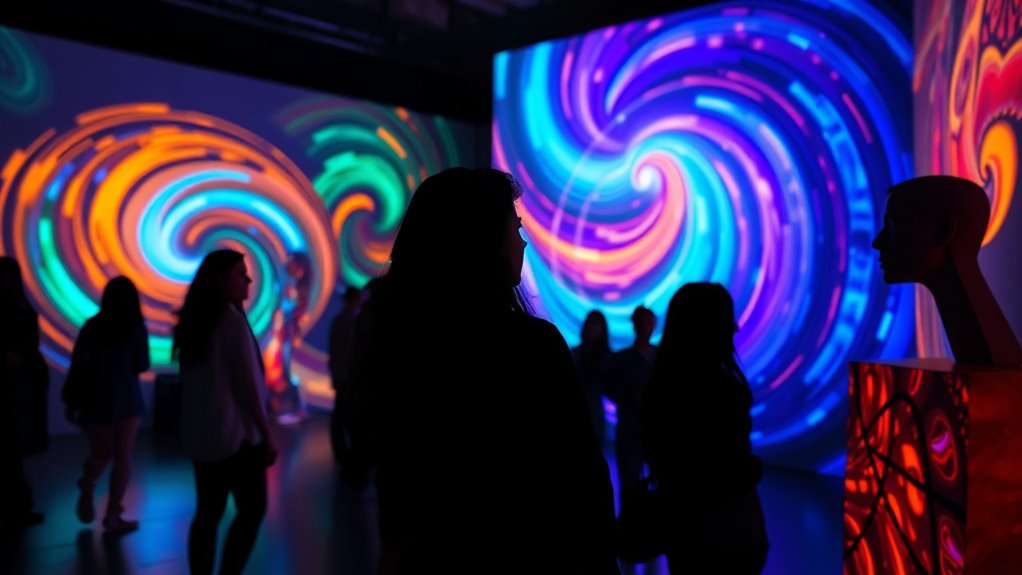
Interactivity transforms immersive art experiences from passive observations into engaging encounters that invite you to participate actively. By integrating augmented reality and participatory sculpture, artists create opportunities for you to influence the artwork directly. For example, using AR devices, you can manipulate digital elements layered onto physical spaces, making the experience more personal. Participatory sculptures encourage you to add or alter components, fostering a deeper connection. This engagement enhances your understanding and emotional response. Think about how these elements allow you to:
- Offer real-time input that shapes the artwork
- Explore digital layers through augmented reality
- Contribute physically via participatory sculpture
- Actor Laurel Coppock has demonstrated how performance can be a form of interactive engagement in media.
These strategies turn viewing into an interactive dialogue, making art a shared experience that’s both immersive and personal.
Notable Examples of Light Projection Art Installations
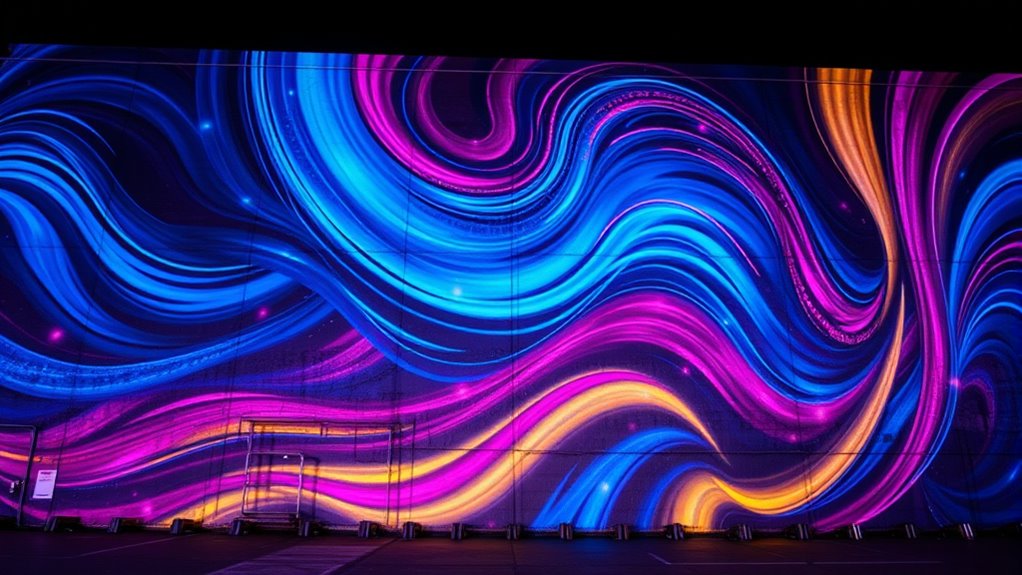
You’ll find that iconic light mappings transform buildings into stunning visual stories, mesmerizing audiences worldwide. Interactive public displays invite you to become part of the art, blurring the line between viewer and creator. Cultural festival installations showcase how light projection elevates traditions and celebrates community identity.
Iconic Light Mappings
Iconic light mappings transform buildings and landmarks into dynamic canvases, mesmerizing audiences with their breathtaking visuals. They turn ordinary structures into extraordinary displays, often featuring vibrant neon signage and intricate laser displays. These mappings highlight architecture’s potential to become immersive art pieces, enthralling viewers far beyond traditional signage. Additionally, the integration of cozy textiles and natural materials can enhance the overall ambiance of spaces, demonstrating how different design elements contribute to immersive experiences. Some notable examples include:
- The Sydney Opera House illuminated with swirling laser patterns
- The Eiffel Tower transformed with animated light projections
- The Burj Khalifa showcasing elaborate storytelling visuals
These installations demonstrate how light mapping elevates landmarks into public art, creating memorable experiences. By combining precise projection techniques with iconic architecture, artists craft stunning visuals that leave lasting impressions, blending technology and artistry seamlessly.
Interactive Public Displays
Building on the visual spectacle of light mappings transforming landmarks, interactive public displays bring a new level of engagement to these artistic installations. You become an active participant, shaping the artwork through your movements and choices. These displays foster audience participation, making viewers feel connected and integral to the experience. Artists often collaborate with technologists and communities to design installations that respond in real-time, emphasizing collective creativity. Such public displays turn passive observation into dynamic interaction, blurring the line between viewer and creator. This fusion of technology and artistic collaboration invites you to explore the artwork’s evolving nature, creating memorable, immersive moments in shared spaces. Incorporating adaptability into the design ensures that these interactive experiences remain relevant and engaging for diverse audiences over time. By involving the public directly, these installations transform urban environments into lively, participatory art experiences.
Cultural Festival Installations
Cultural festivals around the world have embraced light projection art installations to create mesmerizing, large-scale visual spectacles. These installations draw on historical influences and cultural symbolism to deepen their impact. By projecting images rooted in tradition, they celebrate heritage while enthralling audiences. For example, during Diwali in India, vibrant light displays highlight mythological stories and spiritual themes. Similarly, in Japan’s Gion Festival, light projections showcase historical motifs that honor local history. These installations often feature:
- Symbols that evoke collective memory and identity
- Visual storytelling rooted in cultural narratives
- Dynamic displays that connect past traditions to contemporary art
- The incorporation of regional heritage in design elements to enhance authenticity
Through these elements, light projections transform festivals into immersive experiences, fostering cultural pride and understanding while engaging viewers in a shared visual language rooted in history.
The Impact of Technology on Visual Art Experiences
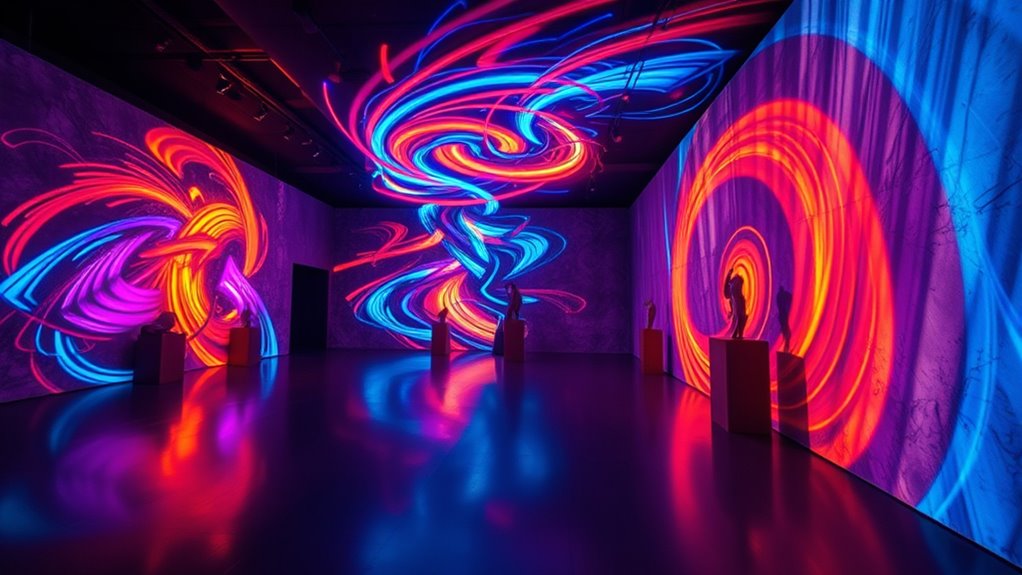
Technology has revolutionized the way you experience visual art, transforming galleries and public spaces into immersive environments. Digital storytelling allows you to engage with artworks through interactive narratives, deepening your connection and understanding. Augmented reality enhances your experience by overlaying digital images onto physical spaces, making art come alive around you. With these tools, you’re no longer a passive observer; you’re part of the creative process. Virtual interactions enable you to explore artworks from different angles and perspectives, fostering a more personal and dynamic encounter. This integration of technology breaks down traditional barriers, inviting you to immerse yourself fully in the artistic environment. Additionally, understanding store hours can help you plan visits to galleries or exhibitions effectively, ensuring you don’t miss out on any special events or extended viewing times. As a result, your engagement with art becomes more vibrant, meaningful, and accessible than ever before.
Future Trends in Light-Based Artistic Expressions

As artists continue to experiment with new materials and techniques, future trends in light-based artistic expressions are poised to push the boundaries of perception and interaction. You’ll see augmented reality becoming integral, blending digital projections seamlessly with real-world environments. Virtual exhibitions will expand accessibility, allowing audiences worldwide to experience immersive light displays from their homes. Expect dynamic, interactive installations that respond to viewer movement and touch, creating personalized experiences. These innovations will foster deeper engagement, making art more participatory. New technological advancements will further enable artists to develop more sophisticated and engaging interactive experiences.
Frequently Asked Questions
How Do Artists Choose Colors and Themes for Light Projection Pieces?
You choose colors and themes for light projection pieces by considering color symbolism and how they evoke emotions or ideas. You think about the story you want to tell, using thematic storytelling to guide your choices. Bright reds might convey passion, while calming blues suggest tranquility. By blending symbolism with your narrative, you create a powerful visual experience that resonates deeply with your audience.
What Safety Considerations Are Involved in Large-Scale Light Projection Installations?
You should prioritize electrical safety, as over 30% of installation accidents involve electrical faults. Keep cables organized, use proper insulation, and make certain equipment is grounded. Crowd management is essential; plan for clear pathways and limit access to projection equipment. Regularly inspect all wiring and hardware, and have emergency procedures in place. These steps help prevent accidents, protect viewers, and guarantee a smooth, safe immersive experience for everyone involved.
Can Light Projections Be Used to Convey Specific Messages or Social Commentary?
Yes, light projections can effectively convey activist messaging and political commentary. You can use projections to highlight social issues, spark dialogue, or challenge viewers’ perspectives. By choosing bold visuals and strategic placement, you engage audiences directly, making your message both visible and impactful. Light projections create immersive experiences that amplify your voice, fostering awareness and encouraging action around important social and political topics.
How Accessible Are Immersive Light Art Experiences for Differently-Abled Audiences?
You’ll find that many immersive light art experiences are becoming more accessible, with over 60% incorporating assistive technology and inclusive design features. These adaptations include audio descriptions, tactile elements, and adjustable lighting. Such efforts guarantee differently-abled audiences can engage fully, creating a more inclusive environment. By prioritizing universal design principles, these experiences become welcoming spaces where everyone can appreciate the transformative power of light projections.
What Are the Environmental Impacts of Deploying Large-Scale Light Projection Technologies?
You should consider that deploying large-scale light projection technologies increases energy consumption, which can strain power resources and raise costs. Additionally, it contributes to light pollution, disrupting ecosystems and reducing night sky visibility. To minimize these impacts, you can use energy-efficient projectors, implement timers, and choose eco-friendly designs. Being mindful of these factors helps balance artistic innovation with environmental responsibility, ensuring your light projections are sustainable and respectful of the environment.
Conclusion
As you step into the world of immersive light projections, you’ll find yourself caught in a dance between technology and creativity, where each display transforms your perception of art. These innovations are like a lighthouse guiding us into uncharted artistic waters, illuminating new ways to experience and connect with creative expression. Embrace this luminous journey, and discover how light can turn ordinary moments into extraordinary memories that linger long after the lights fade.

